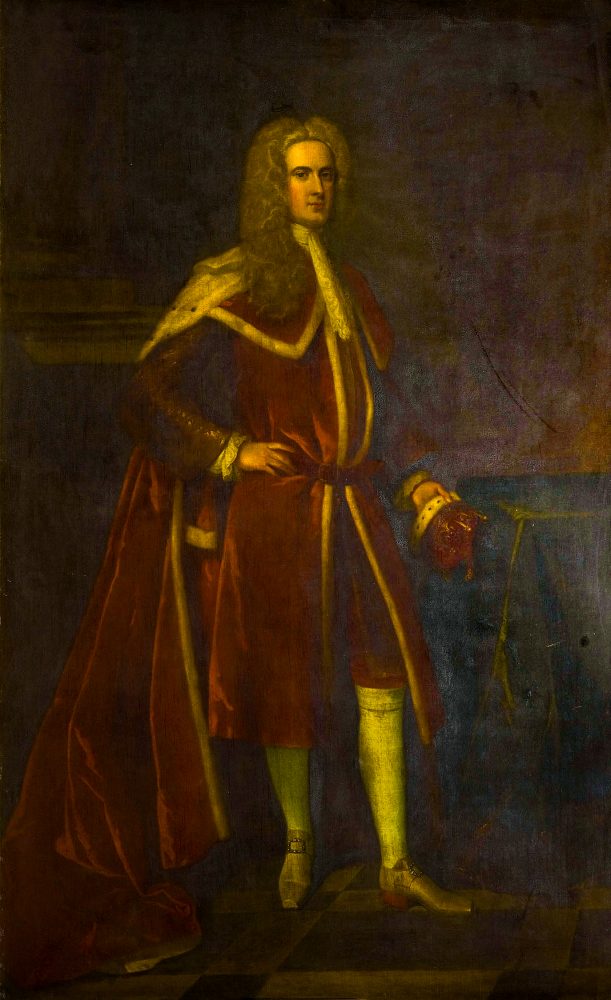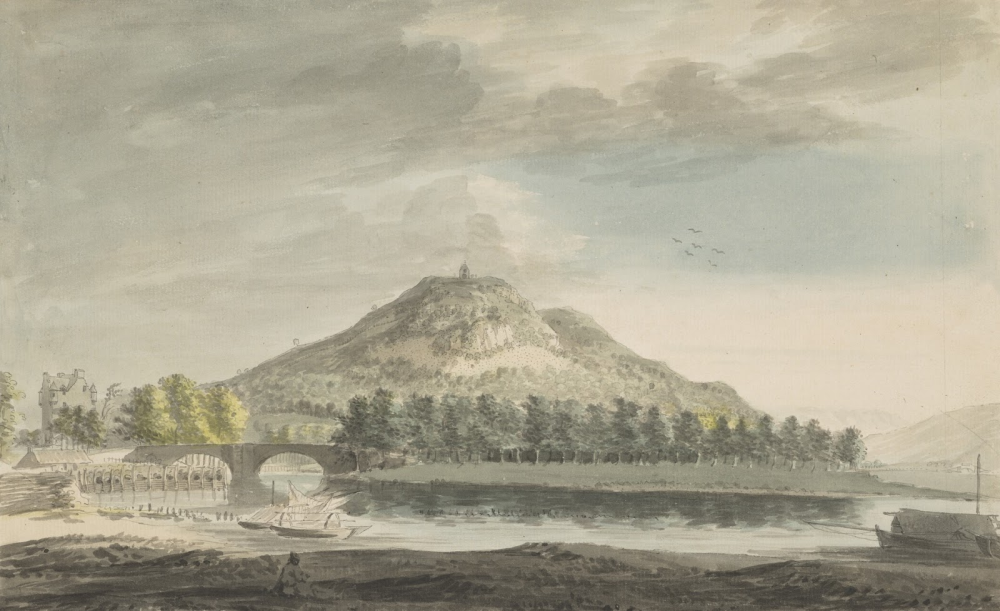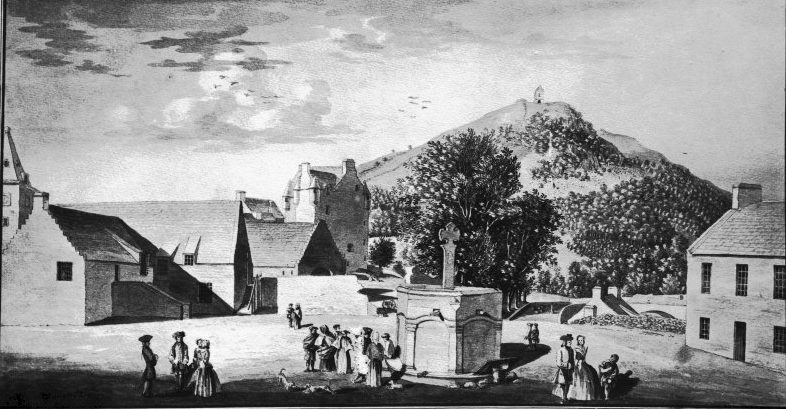In October 1715, the western Jacobite clans under Major-General Alexander Gordon of Auchintoul marched into Argyllshire with the intention of capturing the town and castle of Inveraray, the capital of Clan Campbell and the seat of the Duke of Argyll, the commander of the government forces in Scotland.

General Gordon’s campaign in the west
After raising the Jacobite standard at Braemar and proclaiming James Francis Edward Stuart as king on 6 September 1715, the Scottish Jacobite leader, John Erskine, Earl of Mar, dispatched Major-General Alexander Gordon of Auchintoul to raise the Jacobite clans of the western highlands and islands who had promised Mar of their support. General Gordon, a seasoned veteran of the French and Russian armies, was tasked with gathering as many clansmen as possible before advancing into Argyllshire and seizing the town and castle of Inveraray on the shores of Loch Fyne.
Following the capture of Inveraray, General Gordon was then to proceed southwards to Glasgow, bypassing the government troops of George I amassing in Stirling, while Mar assembled the main Jacobite army at Perth. At the Jacobite assembly at Braemar, Colin Campbell of Glendaruel had assured Mar that the western clans would have little trouble securing Argyllshire on their way south and that a number of Campbell lairds were willing to join the Jacobites.
Around 20 September, General Gordon arrived at Achallader in the Braes of Glenorchy where he established his headquarters and awaited the arrival of the clans. He was soon joined by Alexander Macdonnell of Glengarry and his clansmen, although they were to wait some time before any of the other clans joined them. On 2 October, General Gordon wrote to Allan Macdonald of Clanranald urging him to get a move on stating that “Glengairy has been at this Place with his Men seven or eight Days… I therefore earnestly beg you will make all haste imaginable”.1
Many clan chiefs were reluctant to raise their clans and join General Gordon for fear that government troops would attack their lands once they had left. Writing to General Gordon on 3 October, Coll Macdonald of Keppoch stated that he was “most anxious” to join him however “the Country People being terrified by the Garrison of Fort William, who threatens to destroy all the Country, how soon ever we leave it.”2
Mar wrote to General Gordon on 4 October stating that the Magregors of Glengyle under their chief Gregor Macgregor, nephew of Rob Roy, had been ordered to march to the Jacobite camp at Achallader. The Macgregors had broken out in rebellion in late September by raiding the shores of Loch Lomond and the Vale of Leven. This action prompted loyalist volunteers from southwest Scotland supported by the Royal Navy to move against the Macgregors in what became known as the Loch Lomond Expedition.
Mar also confirmed his original orders to march on Inveraray and stated that since the “Men with you will not be over-well armed; but what they want of that can be well supplied at Inverary”.3 Mar had just been informed by Glendaruel that a large number of muskets had been delivered to Inveraray and he was keen for General Gordon to get there as soon as possible to secure them. The dithering of the clan chiefs would however delay his march.
By 12 October, General Gordon had been joined by the Macdonalds of Clanranald, Macgregors of Glengyle, Macleans of Duart, Macdonalds of Glencoe, and some of the Earl of Breadalbane’s Campbells under Glendaruel, nearly 2,000 men in total. There was however still no sign of the Macdonalds of Keppoch, Camerons of Locheil, or the Stewarts of Appin and General Gordon, who had long since lost patience with the chiefs, complained to Mar that they had “shown such unpardonable Backwardness”.4 Unable to wait any longer General Gordon and his forces marched towards Inveraray on 17 October.

The defence of Inveraray
Anticipating a Jacobite threat to Argyllshire, General John Campbell, Duke of Argyll and commander-in-chief in Scotland sent orders on 16 September to Colonel Alexander Campbell of Finab to march with his Independent Highland Company to Inveraray. Once there Colonel Campbell was to raise the Argyllshire militia and put the town into a state of defence. He was also instructed to send for arms and ammunition from Glasgow and to do his utmost to prevent the disaffected clans, including branches of Clan Campbell, from joining the Earl of Mar.
As the Jacobite clans were beginning to gather at Achallader, Colonel Campbell offered Cameron of Locheil, Stuart of Appin, Campbell of Auchinbreck, Campbell of Lochnell and the Earl of Breadalbane’s Campbells protection and the Duke of Argyll’s friendship if they were to march their men to Inveraray for King George’s service. While Colonel Campbell was only able to dissuade Auchinbreck and Lochnell from joining the Jacobites the negotiations did delay the others for a time while they considered their options. Both Auchinbreck and Lochnell marched their men to Inveraray and served in the Argyllshire militia.
On 6 October, Argyll sent his brother Archibald Campbell, Earl of Islay to take command at Inveraray. Not wanting a repeat of the sacking of Inveraray when the Royalist clans plundered and burned their way through Argyllshire in 1644, Islay had entrenchments dug, barricades established and drystone walls with small bastions erected. He also had a number of outlying buildings demolished to prevent their use by the Jacobites. Islay reported that he had doubled the size of the militia which he placed as a garrison in the town.5
The militia in and around Inveraray numbered over 1,000 and “were very well arm’d and disciplin’d by some Gentlemen that had Serv’d in Queen Ann and King William’s Wars”.6 They were exercised in regular drill and from behind their entrenchments and fortifications were capable of putting up stiff resistance and inflicting heavy casualties on any force that attempted to storm the town.

The siege of Inveraray
After leading his forces out from the camp in the Braes of Glenorchy on 17 October, General Gordon headed down Glen Orchy and into the Strath of Orchy before marching to the head of Loch Awe and the Earl of Breadablane’s stronghold of Kilchurn Castle where they likely stopped for the night. From here they moved south into Glen Aray, following the River Aray and approached Inveraray from the north, arriving on the outskirts of the town late on the 18th.7
General Gordon reconnoitred the town and after observing the defences that were in place marched his forces a mile back up the River Aray to the Carloonan Mill where he established a camp. The following morning General Gordon marched his men out from the camp and drew them up outside the town, likely as a show of force intended to intimidate the garrison. Realising that he would not be able to take the place without incurring heavy losses he marched back to the camp and set about establishing a blockade. That same day the Jacobites were reinforced by 200 of Breadalbane’s men led by John Campbell of Glenlyon, the son of Robert Campbell who had carried out the Massacre of Glencoe.
On the night of the 21st, a party of Jacobites, supposedly led by Rob Roy, were able to sneak into the town and attack a company of the garrison that was stationed near the church. The Jacobites fired on the militiamen however they were “so warmly received by them, and thereafter round all our wall, that upon his return he says he would go half way to hell before he would go back”.8
It is not certain if Rob Roy was involved in the incursion or if this was yet another myth about him. There is evidence that he and the Macgregors were absent at the time. On the 22nd, Gregor Macgregor of Glengyle wrote to General Gordon from the “side of Lochfine” informing him that he and his clansmen had seized a boat along with its freight.9 Clearly, this was an unauthorised enterprise and in reply General Gordon sent a brusque message ordering Glengyle to return with his own and his uncle’s (Rob Roy) men to the camp.10

Writing to John Campbell, Lord Provost of Edinburgh on 22 October, Islay reported that Inveraray was surrounded by the Jacobites but stated that he was confident in the defences that he had established and that he believed that the Jacobites would not risk an all-out assault on the place.11
Prior to the arrival of the Jacobites, some horsemen that had been summoned from Kintyre arrived in Inveraray. The men were quartered in the town while the horses were put out to pasture on the east side of the River Aray. One night during the siege the horses were spooked and bolted back across the river towards the town. The noise of their hooves alerted the garrison who thought that Jacobite cavalry was advancing. The panicked militia were relieved to see the horses emerge from the darkness without riders.
On the night of 24-25, a sergeant and his party were out on patrol in the northern quarter of the town overlooking the Jacobite camp. The sergeant was challenged by a sentry, and after giving the wrong password was fired upon. The sergeant and his party were unscathed however the firing alerted the town and believing that an attack was underway, Islay ordered the drums to beat to arms and the militia assembled under torchlight on the castle green.
No attack on Inveraray was to come. On the 25th General Gordon broke off his siege and led the Jacobites back up Glen Aray and back to the camp in the Braes of Glenorchy before heading towards Perthshire to link up with the main Jacobite army under Mar. On 13 November Mar’s Jacobite army clashed with the Duke of Argyll’s government forces in the inconclusive battle of Sheriffmuir which effectively ended the Jacobite Rising of 1715.
Notes:
- Major-General Alexander Gordon to Allan Macdonald of Clanranald, Achallader, 2 October 1715, A Collection of Original Letters and Authentic Papers, Relating to the Rebellion, 1715, (Edinburgh 1730), p 23. ↩︎
- Coll Macdonald of Keppoch to Major-General Alexander Gordon, 3 October 1715, A Collection of Original Letters, p 23. ↩︎
- Earl of Mar to Major-General Alexander Gordon, Perth, 4 October 1715, A Collection of Original Letters, p 51. ↩︎
- Major-General Alexander Gordon to Earl of Mar, Achallader, 9 October 1715, A Collection of Original Letters, p 62. ↩︎
- SP 54/9/21: Earl of Islay’s report on the defence of Inveraray, 7 October 1715. ↩︎
- Robert Campbell, The Life Of The Most Illustrious Prince John, Duke Of Argyle And Greenwich, (Belfast 1745), p 185. ↩︎
- Gentleman’s Magazine and Historical Review, vol 15, 1745, p 469. ↩︎
- A. Whitford Anderson (ed), Papers of the Rev. John Anderson, Minister of Dumbarton, 1698-1718 (Dumbarton 1914), p 35. ↩︎
- Gregor Macgregor of Glengyle to Major-General Alexander Gordon, 22 October 1715, A Collection of Original Letters, p 101. ↩︎
- Major-General Alexander Gordon to Gregor Macgregor of Glengyle, 22 October 1715, A Collection of Original Letters, p 102. ↩︎
- SP 54/9/74: Earl of Islay’s report to John Campbell, Lord Provost of Edinburgh, 22 October 1715. ↩︎
Cite this article: Ritchie, N. (25 October 2023). Siege of Inveraray during the Jacobite ’15. Scottish History. https://www.scottishhistory.org/articles/siege-of-inveraray/

